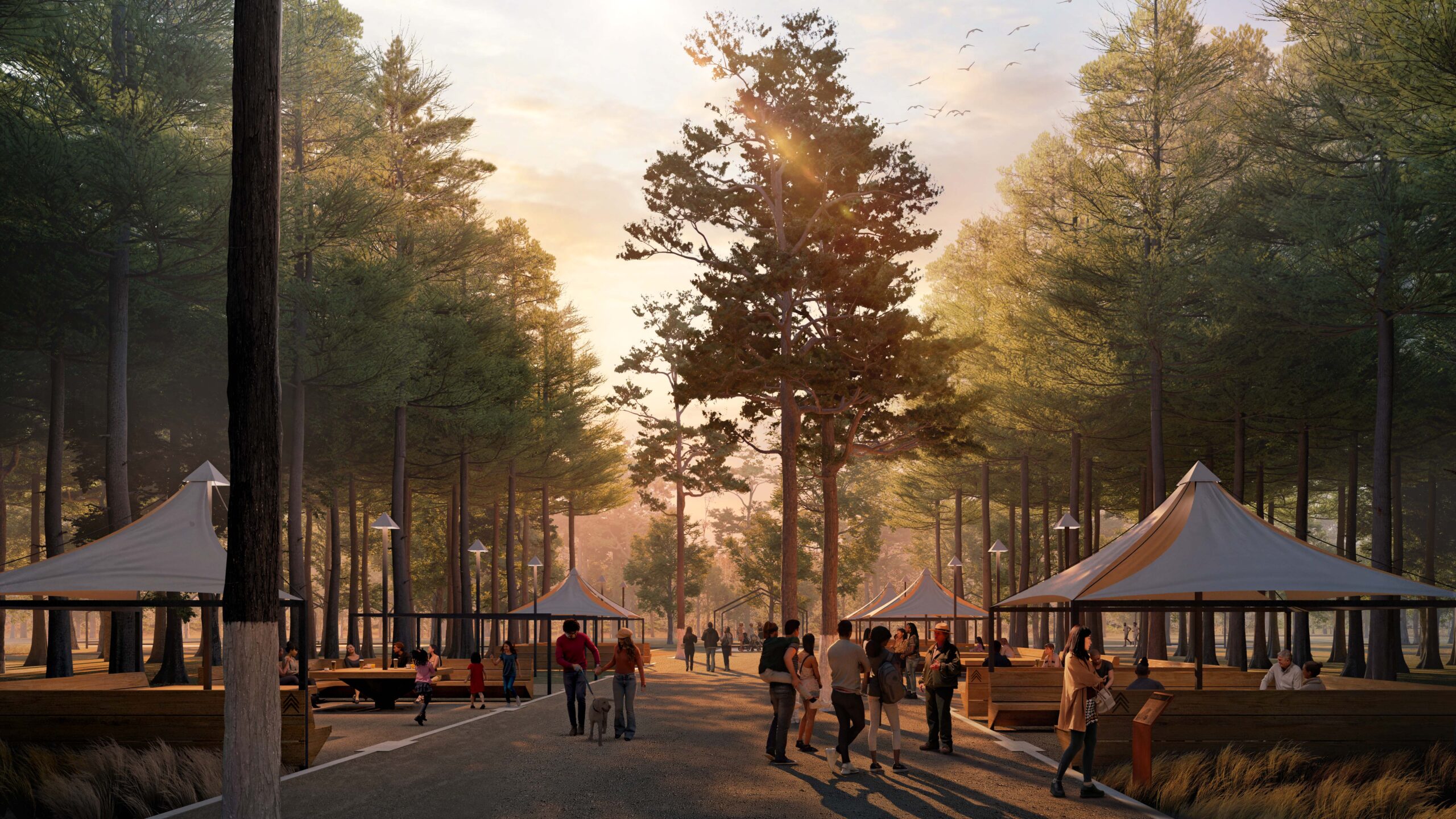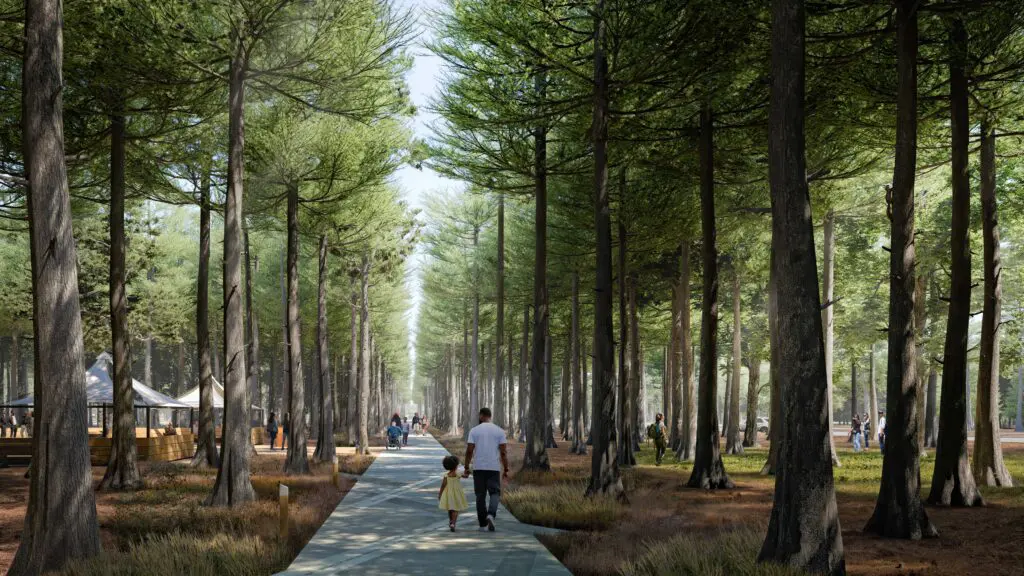Speaking With The Trees — Houston’s Memorial Park Will Finally Live Up To Its Name With Sacred New $42 Million Memorial Groves Nature Land
Famed Landscape Architect Thomas Woltz Honors Camp Logan and Its Troubled World War I History With a Living Memorial
BY Chris Baldwin // 04.22.25The new Memorial Groves will finally put the memorial into Memorial Park.
Famed landscape architect Thomas Woltz is putting the memorial into Houston’s Memorial Park with the latest new ambitious project in the reimagining restoration of the Bayou City’s largest lifeline public green space. The new Memorial Groves aims to honor the oft-forgotten Camp Logan, a massive World War I training ground in the rugged wilderness of 1917 Houston, while also nodding to nature with a forest of young trees. This $42 million addition to the park will be a living testament to sacrifice and the wild natural beauty Woltz’s been fighting to make people recognize.
Memorial Park never lived up to its name, even as it became the anchor of so much in Houston life. Not really. “The park was always called Memorial Park, but few people knew why,” Thomas Woltz, the landscape architect who’s redefining what people think of that title, tells PaperCity.
Spend any time around Woltz, who always seems to be moving, bounding here or there, sending a torrent of measured but urgent thoughts your way, and one quickly realizes this is someone who always wants to know the why. Before you can listen to the land and the trees, you need to truly grasp the history. Before you can dig into the dirt, you need the dirt on what actually happened.
Houston’s mammoth urban park does not carry the famous ghosts of another one of Thomas Woltz’s grand restoration projects — the grounds of Thomas Jefferson’s Monticello. Memorial Park’s stories are much less known; but no less important or weighted in Woltz’s view.
Memorial Park originally came to be in 1924 centered around the idea of honoring the 70,000 soldiers who trained at Camp Logan for World War I on what would become park grounds. Now, more than a century later, the memorial of Memorial Park is finally happening, part of the Memorial Park Master Plan that’s reimagining the largest public green space in Houston, a sprawling swath of land nearly twice as large as New York’s Central Park.
Introduce yourself to Memorial Groves, even as you banish any thoughts of those statues of soldiers, often struggling to raise a flag, or thrusting bayoneted guns forward, that have become the domain of typical war memorials. There will be no paved plaza or heroic figures frozen in stone. Thomas Woltz and his Nelson Byrd Woltz Landscape Architects conjured up something much more organic, a living memorial to all those young men who sacrificed and lost their lives in the savage combat of what historians somewhat callously deem The Great War. And those who lost their lives and suffered in the 1917 Houston riot (and its long aftermath) sparked by racial tensions between the African-American soldiers of the 24th Infantry serving at Camp Logan and the Houston police.

Those fragile lives will be represented by trees, one of Houston’s most breakable, precious and priceless resources.
“The average age of the soldier killed in World War I was 24,” Woltz says. “It was also a very young war. And so we thought planting a memorial and watching it grow might even be for the early years a reminder of the youthfulness.”
This $42 million Memorial Groves project is being powered forward by donations from the Kinder Foundation ($10 million), businessman, philanthropist and American history preservationist John L. Nau, III ($7.5 million) and the Brown Foundation ($7.5 million).
“What excites us is that Memorial Groves will remind visitors why this park is called Memorial Park,” Nancy Kinder says.
“Memorial Groves will highlight a piece of Houston’s World War I era history that has been under-told and is at risk of being forgotten,” says Nau, who is considered the top collector of Civil War artifacts in the world.
PaperCity received a rare detailed early look at. Memorial Park’s newest major addition with exclusive one-on-one interviews with Thomas Woltz and more of the major figures involved.
The Quiet Place
If the Land Bridge, the Eastern Glades and prairie projects are the dramatic showpieces of the groundbreaking Memorial Park transformation, this new 100-acre Memorial Groves promises to be something quieter and solemner. Picture a cathedral of trees, transforming a neglected, almost forgotten strip of the massive park, running from West Memorial Loop to the railroad tracks.
It’s a long and narrow stretch, a parcel of land which few people ever visited. Something someone might stumble upon, not seek out. Research, much of it led by a cultural advisory group helmed by Memorial Park Conservatory president emeritus Shellye Arnold, revealed this dismissed and almost discarded strip carries historical significance though.
“There’s a moment where you hold hands with history.” — landscape architect Thomas Woltz.
That rail line connected Camp Logan to the rest of the world. It’s where soldiers arrived to drill and where they were eventually first sent off to war, the opening steps in their journey to the frontlines in France.
This is where Woltz and his team would plant trees 16 feet apart, a forestry standard practice that almost eerily channels the spacing used in military regiments — six-men tents set 10 feet apart. Acres of newly planted cypress trees (more than 2,000 cypress overall) and acres of interplanted trees now accompany the few trees on this stretch that survived a devastating drought.
The new Memorial Groves also pays homage to the trench warfare that made World War I so often claustrophobic and bloody. The soldiers at Camp Logan tirelessly trained to build the 12-foot deep trenches with benches and sloped sides that they would later construct under duress in Europe. Early on, Thomas Woltz realized that digging down 12 feet was not practical or fitting for a place meant for meditation. He would flip the script, turn the idea right side up.
“What if we reimagined the trench?” he says. “Instead of digging down 12 feet, we could build up 12 feet.”
With soil. Twelve-foot-high earthen mounds will create a space — a long rectangular space with trees inside and a 50-foot-long table with an inch of water on it — that’s meant to connect the sky to the ground. It will be a place for reflection, and Woltz hopes, one of the more beautiful places in all of Memorial Park.
“What excites us is that Memorial Groves will remind visitors why this park is called Memorial Park.” — Nancy Kinder

One where nature is allowed to star. Woltz may often look like he stepped straight out of the pages of GQ magazine, with his perfectly coiffed gray hair and stylish clothes never seemingly rustled even as he charges up a hill. And it’s true that this versatile 58-year-old charms at dinner parties with an easy grace and authority. It’s no stretch to suggest he’s the first celebrity landscape architect. But at the heart of it, he remains the boy raised on a cattle farm in Mount Airy, North Carolina (the birth place of Andy Griffith) who wants to meet nature on its terms.
“A prairie establishment is a rough-looking process,” Woltz says. “If people just want a golf course-like setting — a prairie to the eye of someone who loves golf looks like abandoned land or rough land. To an ecologist, it looks like this healthy, fertile, stable ecosystem that can tolerate fire and drought.
“To me I look at a prairie and think, that’s a superhero right there. That’s an incredibly strong and resistant living thing. Full of birds and wildlife. I see it as this beautiful thing.”
The Lorax himself couldn’t have said it any better.
When Nature Wins
Some of the early criticism of Thomas Woltz’s work at Memorial Park came in people declaring it too wild, too unkempt, too untidy and un-mowed. Woltz has watched some of that carping fall away over the years as the Memorial Park Conservancy’s accelerated Ten-Year Plan, initiated in 2018, races into its second half. Sometimes, he just likes to watch and see how people interact with this more natural park.
“I do that on every trip to Houston,” Woltz reveals. “I go and just sit up on the West mound of the Memorial Park land bridge, over the prairie. I’ll just sit up there and watch folks. I had a really moving experience where a young couple got engaged to me right next to the overlook on the Eastern Glades.
“I was just sitting there, waiting to meet somebody, and this couple was just sitting next to me and kind of kissing a little bit. Sparking as my grandparents would say. And the young man dropped down on one knee and asked her to marry him and said, ‘This is the most beautiful place that I can imagine asking you to marry me.’ ’’

Thomas Woltz isn’t about taking a victory lap. Especially with so much more still to do at Memorial Park to keep it set up and healthy for the next 100 years. Still, in that little moment, he thought of the battles waged to get here.
“The people who fought against those projects and said that they were terrible projects, that they were destroying the park,” he says. “That we were doing all this bad stuff. If they could have seen that couple get engaged, I think they would have realized Memorial Park is transforming into one of the great public spaces in the United States.”
Woltz sees Memorial Groves as the next step forward, one that harkens back to the park’s forgotten original purpose, what Will and Mike Hogg imagined when they sold the land for Memorial Park to the City of Houston at cost. A new playground, workout areas meant to mimic some of the training those Camp Logan soldiers went through, a day in the lives of the soldiers exhibit, acknowledgements of the racial abuse that the soldiers of the 24th Infantry Regiment (one of four Buffalo Soldier regiments in the U.S. Army) endured in Houston, and biking and hiking trails will be part of these groves. To Woltz, it’s about being there though, hearing and seeing the trains, taking in the natural surroundings and those young trees.
“There’s a moment where you hold hands with history,” Woltz says. Maybe a moment where Memorial Park’s name suddenly carries more weight and meaning.























_md.jpg)

_md.jpg)








_md.jpg)








_md.jpg)
























_md.jpg)





_md.jpg)

_md.jpg)


